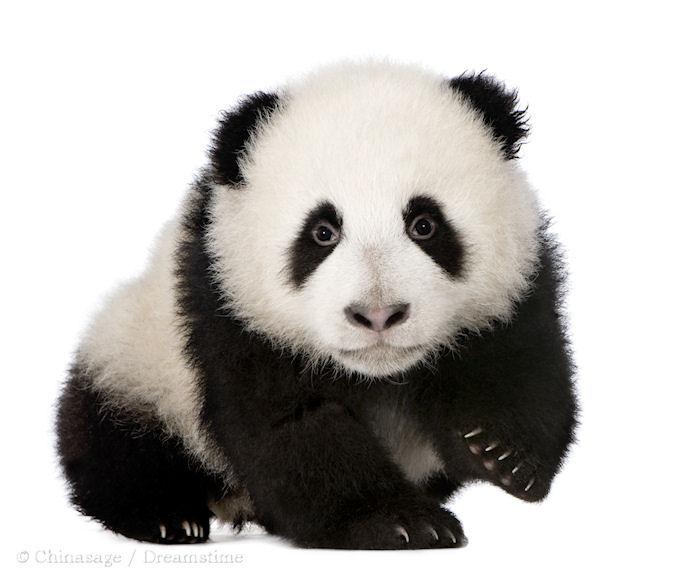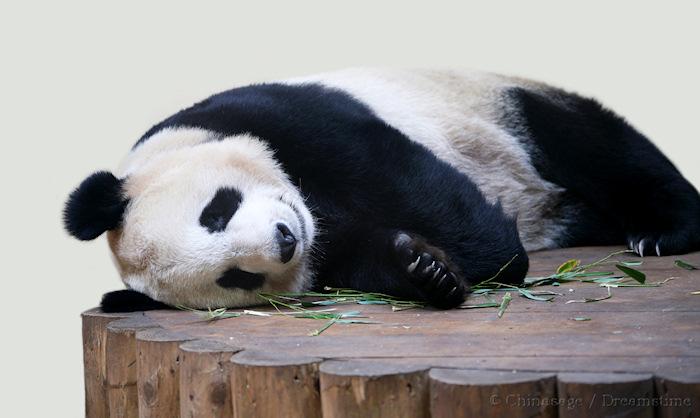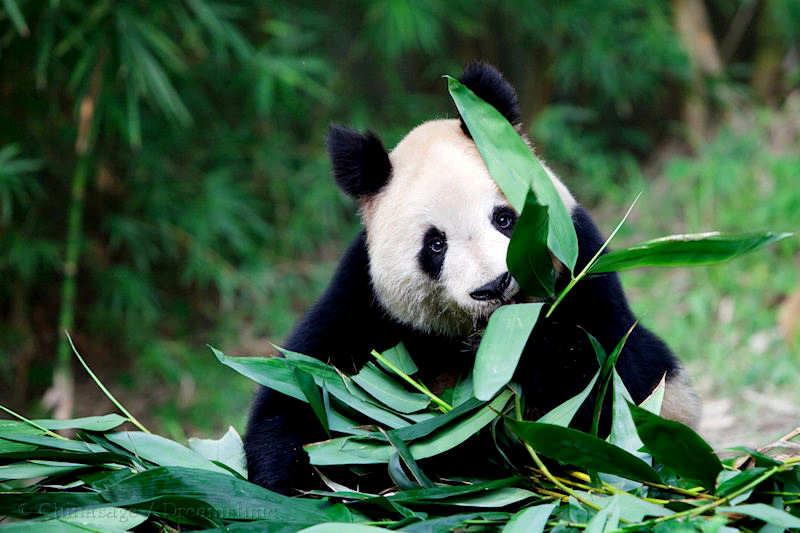Giant Pandas in China

The emblem of the World Wildlife Fund ➚ is the undeniably cute Giant Panda of China. This is one reason why so many people wish to see Giant Pandas when visiting China.
Once much more widespread, the Giant Panda is now restricted to remote mountainous terrain in Sichuan, Shanxi and Shaanxi provinces. The panda is vegetarian and eats mainly a few species of fairly indigestible bamboo. To keep up energy levels vast amounts of bamboo need to the eaten, about 50 pounds [23 kgs], every day. After decades bamboo flowers and then dies, and this event sometimes can cause pandas to starve to death as the bamboo flowers at the same time over a large area. In the winter of 1975/76 about 150 pandas died of starvation. The problem is more acute now that their habitat is in isolated pockets. It lives a solitary life, meeting up only briefly for mating. For many years the mating behavior was not fully understood and this led to great difficulty in breeding them in captivity. For this reason artificial insemination is often used for fertilization and the cubs are then raised by hand. Unusually for mammals they remain totally dependent on their mothers for over a year. In the wild the mother can only support one cub and if more than one is born then only one is chosen and the other one abandoned. The young cub is born blind, about 100g in weight and unable to move. The eyes open after about 45 days and it only starts to crawl after three months. At five months it starts eating bamboo and is fully weaned after another month. The captive breeding program has raised enough panda cubs to allow them to be released back into the wild as well as sent to zoos across the world.
Although bamboo is the staple and often preferred food, Pandas will eat other vegetation and other food including honey and berries, they can survive without bamboo for a short period, their front paws have evolved specifically to grasp and process bamboo shoots. It might be expected that their stomachs have evolved to extract nutrition from bamboo, but this is not the case, they take only 50% of the energy content of it. This is why they have to eat for 10to 12 hours a day. They fell 16 feet [5 meters] bamboo plants shoots and ignore the lower woody part. In captivity they are given supplements to ensure good overall condition, including chocolate and vitamins, the famous London Panda, Chi-Chi, was partial to roast chicken and tea.
It is not an aggressive animal, it lost its appeal for early hunters because it does not attack - it climbs trees to avoid dogs rather than attack them. It only walks and never runs but when severely antagonized it will use its very powerful jaws to bite, giving any attacker a serious injury.
One of mysteries and attractions of the panda is its distinctive blank and white colored fur. Like the zebra the reason why these eye-catching contrasts has been the subject of speculation. Unlike the zebra it has no natural predators and so being visible from a distance is not a problem in fact it may be helpful for males seeking out females in the vast, mountainous habitat.

Panda Origins
About the same size as the American black bear they reach 220 pounds [100 kgs] (males 250 pounds [113 kgs]) in weight. Some years ago their status as a member of the bear family was in dispute, it was thought that they might be more closely related to raccoons and the red panda. However, DNA tests have shown the panda is indeed a member of the bear (Ursidae) family with the Spectacled Bear ➚ one of its closest relatives. Remains of a now extinct ancestor, the Dwarf Panda ➚ have shown that pandas evolved in isolation over millions of years. The name used in English 'panda' has an unknown origin; the Giant panda was named due to superficial similarities to the Red or Lesser Panda ➚. For the period 1820-1869 the red panda ➚ was the only panda known; it lives in mountainous Nepal and is mainly nocturnal living on bamboos and berries. It hisses and spits like a cat. In China the giant panda goes by a variety of names including white bear, spotted bear and bamboo bear. The most common name used is 大熊猫 dà xióng māo large bear cat or just bear-cat.
The Pandas do not appear much in Chinese historical records. There is a possible reference to a ‘white bear’ in 621CE when 70 skins were presented to the Emperor. It is very unlikely that these 'white' bears were polar bears and names were rather variable at the time. The next mention comes much later during the Qing dynasty when the local tribes on the Tibet/Sichuan border area presented bear skins as tribute to the Emperor. Fortunately for the panda the fur is too coarse to make nice coats and was used for bedding and rugs. It also seems that their meat was not tasty so they were not hunted for food. The fact that they lived in such remote and mountainous terrain among independently minded tribes explains why they escaped mention. It was the great French naturalist and missionary Père David ➚ who brought them to European attention in 1869. At first he considered them a new species of bear but later bowed to analysis of teeth and bone structures to place them in the same group as the Red Panda; it was from this that it took its common name 'Giant Panda'. Science has now proven that his initial suggestion as a type of 'bear' was in fact correct.
Panda Trophies
After the Panda discovery in 1870 the period up to about 1930 was dominated by trophy hunters. The rarity of the animal and the inhospitable territory in which it lived added to the allure of the chase. Many hunters launched missions into mountainous northern Sichuan to bag a wide variety of animals not specifically the giant pandas. The animosity of the local Yi people was also an obstacle, they even killed one explorer. One long hunt in 1916 only caught a single glimpse of a Panda. People began to think the panda had become extinct. Colonel Theodore and Kermit Roosevelt ➚, sons of President Teddy Roosevelt ➚ took part in hunts. Further parties managed to befriend the Li people and then used them as guides to help find the elusive animal. The Li people said they only attacked pandas when they came to raid their beehives - pandas have a taste for honey just like other bears. On 13th March 1928 a male panda was shot and the body examined giving new information about Panda anatomy. In 1931 Chicago zoo bought the body of a female panda. In all about 15 skins or skeletons were sent to US in the period 1929-42 but only about a dozen were deliberately shot. It is unlikely at this time that a panda would have survived long transport by boat and the analysis of bodies did confirm the panda to be a rare and unique species.
By the 1930s the extreme rarity of the animal had been established and the hunt moved from shooting to capturing pandas. The British panda expert Floyd Tangier-Smith ➚ was locked in fierce rivalry with a U.S. team of Bill and Ruth Harkness ➚. It is claimed Floyd captured the first live panda but it died en route back to London. Ruth Harkness however managed to buy/capture a baby panda called Su Lin ➚ (the details are murky), still suckling, and on 18th December 1936 the two arrived at San Francisco to a rapturous press and adoring public.
Zoo Pandas
The first Panda was taken on by Chicago zoo and received many visitors. Panda toys, ornaments and emblems became very popular. But Su Lin died on 1st April 1938 aged only a year and a half. A male panda Meimei had been bought and sent as a mate for Su Lin and he lived for over four years at Chicago zoo. Su Lin turned out not to have been female but a male - assigning the incorrect gender for pandas proved to be a problem that was repeated many times - they are very similar anatomically. Meanwhile Tangier Smith succeeding in capturing five pandas to be sent to London in 1938, but two died in transportation but Song, Tang and Ming all reached London Zoo and the panda craze was kindled in the U.K.. The King and Queen visited as well as the young Princess Elizabeth. During the Second World war the only surviving London panda Ming was evacuated to Whipsnade Zoo ➚; but all three London pandas had died by 1944.
In the war years access to Sichuan became increasingly difficult. Hunting parties of 70 local people were formed. However the popularity of pandas had now made the Chinese government realize that they had to manage their own precious and rare animals. ‘Panda diplomacy’ was born, when Chiang Kaishek gave a ‘pair’ of pandas to the U.S. ‘Pandah’ and ‘Pandee’ ➚ in December 1941. Following the end of the second World War, China entered the Civil War that ended in 1949 with Communist victory. With very poor relations between China and the US, American zoos were denied requests to import pandas even though they were very much in demand. The panda Mei Lan at Chicago broke records by living for 13 years but when he died in 1953 there were no pandas left alive outside China.

Panda Conservation begins
The new government of the People's Republic soon set about protecting and promoting the giant panda. No longer were Western adventurers allowed to wander around hunting in remote Sichuan. Soon it was Chinese zoos that had pandas to display to an adoring public; Beijing Zoo led the rest. It was a deal with Beijing Zoo in 1958 that brought the famous panda Chi-Chi (姬姬 Jī jī 'princess') to London Zoo, she was exchanged for a number of large African wild animals (giraffes, rhinos etc.). Attempts in 1966-69 to mate Chi-Chi with An-An, the only other exported panda, living at Moscow Zoo failed. By that time it is believed Chi-Chi was too old to conceive. Meanwhile in 1963 the first panda cub Li-Li was born in captivity at Beijing Zoo. Both Chi-Chi and An-An died in 1972. It was the enduring popularity of Chi-Chi at London that led the World Wildlife Fund ➚ to adopt the bear as their emblem.
In the 1960s no pandas were sent from China. It was only after the ground-breaking Nixon visit of 1972 that panda diplomacy began again with this time pairs of pandas being sent as gifts in appreciation of support for the PRC. As understanding of the unique breeding requirements of Giant pandas grew, more births followed. With artificial insemination and human nurturing the success rate has continued to rise.
China gave a pair of pandas to London Zoo in 1974 Chia Chia (female) and Ching Ching (male). They failed to mate and Ching-Ching died in 1985, Chia-Chia then went to Mexico's zoo to try to mate with a single panda held there, but again failed. Their replacements in London Ming-ming and Bao-bao were an even worse choice as they fought with each other and eventually were sent back to China. The current deal is for a zoo to pay $1,000,000 a year to China to lease a panda. Edinburgh Zoo ➚ kept 甜甜 Tián tián 'sweetie' and 阳光 Yáng guāng 'sunshine' from 2011 until 2023. They were on a ten year loan, which was extended due to the Covid pandemic

Two types of Panda
It was only in 2005 that it was discovered that there are two subspecies of giant panda. The Qinling panda (Ailuropoda melanoleuca qinlingensis) has different coat coloring (dark and light brown rather than black and white) making it look like a washed out version. It has a smaller skull and is slightly smaller. There are only 345 (in 2018) in the wild that live in the Qinling mountains (on the border of northern Sichuan and Shaanxi provinces). A special reserve of 1,390 sq miles [3,600 sq kms] has been allocated to them and numbers have been slowly rising. It is believed that they became geographically isolated from the familiar giant panda species many thousands of years ago.
Where to see Pandas
Woolong Reserve ➚ 25 miles [40 kms] west of Chengdu, Sichuan is the best known reserve. It was set up jointly with the World Wildlife Fund. In total there are about 270 pandas in captivity and somewhere between 1,000 and 3,000 in the wild; they are rarely seen as they inhabit dense bamboo thickets and are spread out very thinly over large areas. Wanglang Nature Reserve 186 miles [300 kms] north of Chengdu is one place they live, but are unlikely to be seen. They inhabit high ground - typically 7,000 feet [2,134 meters] mostly in northern Sichuan north of Chengdu.
Breeding Pandas at Wolong
It was vital to build up numbers quickly to avoid possible extinction of the species. In the wild, pandas often have twins but only one ever survives - because the mother panda has insufficient food for both. To get around this problem Wolong instituted twin swapping. During the long period of breast feeding one cub is left with the mother and the other is fed by staff and kept in an incubator, after a few weeks or months the twins are swapped around and this continues until the cubs are no longer dependent on the mother. Also by providing a more nutritious diet and hand rearing the young cubs, the mothers can give birth every year rather than every two or three as in the wild. Although this scheme has successfully reared about 100 cubs the approach leads to heavy dependence on the human carers and it is not clear whether they can cope entirely alone if released into the wild. The Chinese government is busy setting up a large contiguous wild area (resettling whole villages in places) so the pandas can be released and roam as naturally as possible.

Diplomatic Pandas
Their iconic status has made pandas an important pawn in international politics. There are currently 44 pandas in thirteen foreign countries ➚: Mexico; Spain; Canada; Singapore; Austria; France; Germany; Malaysia; Japan; Thailand; Belgium; Taiwan and Australia. In China there are pandas at Beijing; Shanghai; Hong Kong and in Sichuan at Chengdu Research Base of Giant Panda Breeding ➚; Wolong ➚ and Chengdu Zoo ➚. Legally all the pandas in the world belong to China, except for two that were born in Mexico.
More recently the only surviving giant panda triplets were born in July 29 2014, and they have now been named: 萌萌 méng méng (adorable), 帅帅 shuài shuài(handsome) and 酷酷 kù kù (cool) they live at Chi me long Safari Park, Guangzhou.

The pair of pandas 团团 tuán tuán and 圆圆 yuán yuán caused a diplomatic stir when they were offered as a gift to Taiwan in 2008, as their names (chosen by public poll) were politically sensitive, the combination 团圆 tuán yuán means re-union - a hot topic between China and Taiwan.
Giant Panda appeal
The universal appeal of the giant panda has been widely commented on. Why does this particular animal capture our hearts so readily? Here are a number of possible reasons: it has a flat face with a small snout; it has apparently large eyes; it has no tail; it sits and uses its hands; it is not aggressive and is vegetarian; it is playful and friendly (most of the time!); it has soft fur making it rounded; it is black and white; it is a giant (elephants and dinosaurs share this attribute); or it is rare or does 'panda' just sound like a nice name?!